Nepal is one of the world’s gems for mountaineering adventure activities. Among the more than thirteen thousand peaks above 6000 meters, 602 peaks are open for mountaineering by the Government of Nepal and the Department of Tourism. Of these, 414 peaks have had open routes climbed by climbers of different nationalities and at different times and 188 remain unclimbed, “virgin” peaks ready for exploration.
In 2013, the Government of Nepal announced a “free permit” policy for peaks below 5800. Due to the sheer volume of peaks in Nepal, the Government of Nepal generally classifies the 6000-meter peaks as “trekking peaks” some of which may require some technical skills (which we describe below). These mountains require trekking permits, whereas the higher and more technical mountains considered “mountaineering” mountains require mountaineering permits. Although Nepal has so many 6000 meter peaks classified as easy, moderate or challenging (creating a suitable climbing experience for adventure seekers), we still require that climbers have previous experience in rock / ice climbing techniques and know how to use an ice axe and crampons, and how to ascend and descend on fixed lines.
Of the 6000 meter peaks open for climbing, Satori Adventures and Expeditions considers the 10 trekking peaks described below as a “top 10” peak based on interest by climbers, number of climbers, and how well known and popular they are among operators and climbers alike. Permits for these peaks are issued by the Nepal Mountaineering Association (“NMA”).
1. Island Peak (6,165m / 20,226ft) 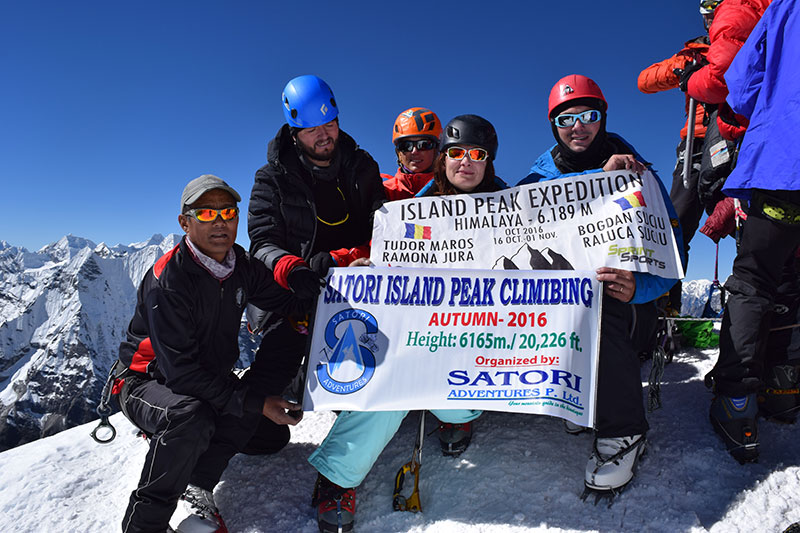 Island Peak is one of easiest 6000 meter mountaineering adventures in Nepal. The first Island Peak climbing expedition was organized in 1953 by a British team including Tenzing Norgay. It offers one of the most impressive views of the Khumbu region as well as Mt Everest itself. The classic trek to Everest Base Camp (“EBC”) is an attractive add-on to the Island Peak adventure.
Island Peak is one of easiest 6000 meter mountaineering adventures in Nepal. The first Island Peak climbing expedition was organized in 1953 by a British team including Tenzing Norgay. It offers one of the most impressive views of the Khumbu region as well as Mt Everest itself. The classic trek to Everest Base Camp (“EBC”) is an attractive add-on to the Island Peak adventure.
The climb follows a steep but simple snowfield with an easy ridge summit. It is a very satisfying peak to climb because it has extraordinary scenery from its summit, it requires teamwork to cross the glacier as well as fixed ropes close to the summit, and it is a pleasant alpine-style climb with a classic rock scramble and relatively short acclimation period. This makes it a suitable option for a fit family, group of friends or even for corporate team building. There is no need to establish a permanent base camp and the terrain is not considered technically challenging, making it a very popular choice for an introductory commercial climb.
2. Mera Peak (6,476m / 21,247ft)
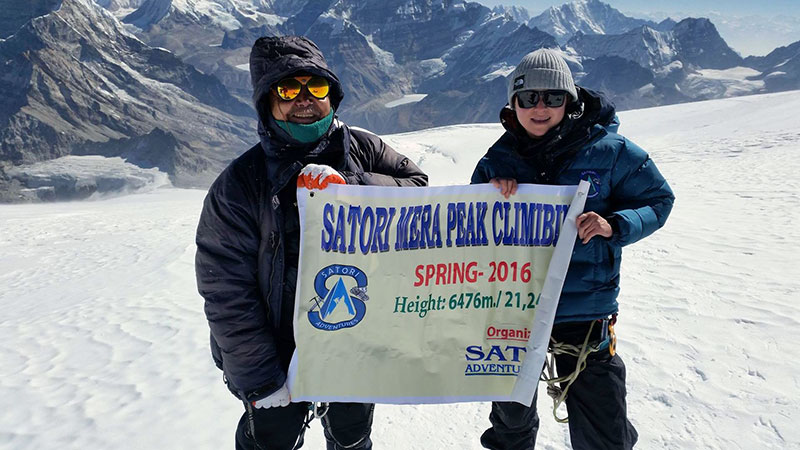 The enchanting Mera Peak is also one of Nepal’s easier and quieter mountains and also its tallest trekking peak. It begins with the classic and spectacular mountain flight to Lukla. Following that is an 11-day trek through the stunning Hinku Valley to Mera’s Base Camp. Although a strenuous trek, it is not technically difficult making it an ideal beginner climb. The trek to base camp is sufficient to prepare you for the summit and it is not necessary to establish a permanent base camp facility for an extended period of time.
The enchanting Mera Peak is also one of Nepal’s easier and quieter mountains and also its tallest trekking peak. It begins with the classic and spectacular mountain flight to Lukla. Following that is an 11-day trek through the stunning Hinku Valley to Mera’s Base Camp. Although a strenuous trek, it is not technically difficult making it an ideal beginner climb. The trek to base camp is sufficient to prepare you for the summit and it is not necessary to establish a permanent base camp facility for an extended period of time.
The climbing history of Mera peak is closely connected with the big names of early Himalayan explorers such as Sir Edmund Hillary, Eric Shipton and George Lowe who formed part of a British expedition that explored the area in the early 1950s. The first ascent was achieved on May 20, 1953 by Col. Jimmy Roberts and Sen Tenzing.
3. Lobuche East (6,119m / 20,062ft)
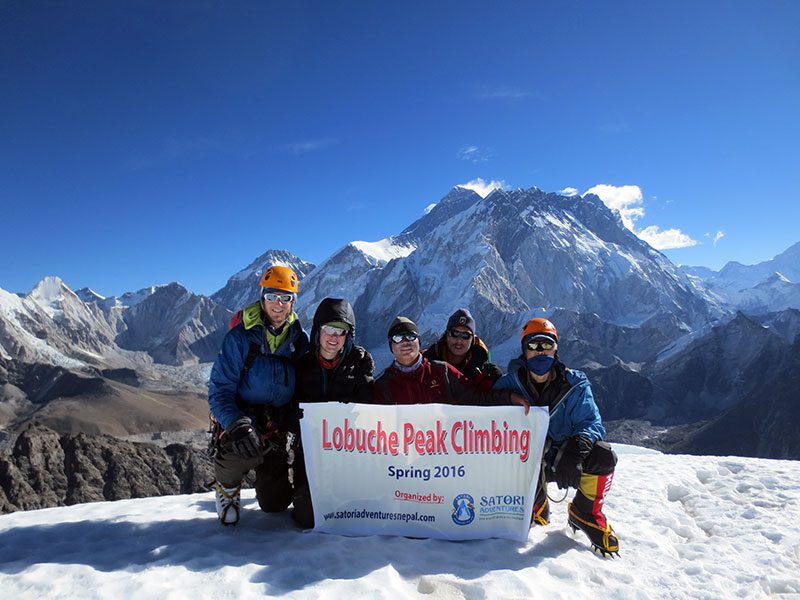 Lobuche East is an exceptional pick for a first Himalayan 6000 meter peak climb with stunning summit views and fantastic views of Lhotse Face, Everest, Pumori, Ama Dablam and many other 6000-meter along the way through the Khumbu Valley. Lobuche East lies close to the Khumbu Glacier and has two main peaks, Lobuche Far East and Lobuche East. The massive Lobuche East peak is located at a latitude of 27°58’08”N and 86°47’05” E with a somewhat secluded peak for greater privacy. In addition, the cost of a permit is very reasonable.
Lobuche East is an exceptional pick for a first Himalayan 6000 meter peak climb with stunning summit views and fantastic views of Lhotse Face, Everest, Pumori, Ama Dablam and many other 6000-meter along the way through the Khumbu Valley. Lobuche East lies close to the Khumbu Glacier and has two main peaks, Lobuche Far East and Lobuche East. The massive Lobuche East peak is located at a latitude of 27°58’08”N and 86°47’05” E with a somewhat secluded peak for greater privacy. In addition, the cost of a permit is very reasonable.
The standard route to Lobuche East is up the South East Ridge. It gained popularity after Laurice Nielson and Ang Gyalzen Sherpa successfully reached the summit from this route on 25 April 1984 around 13:00 pm. The South and Southeast Ridges form a distinctive rock triangle which extends from the summit to the Khumbu Glacier. Lateral moraines with stone memorials make the ridges easily identifiable. This is one of our classic tea house treks with camping arrangements at base camp and high camps. Your adventure begins right after you depart Kathmandu for the historic village of Lukla. The trek to Lobuche peak will take you through Namche Bazaar, Tengboche, Dengboche and Lobuche Village itself. EBC and the nearby Kalapather will provide excellent acclimation opportunities before attempting the summit.
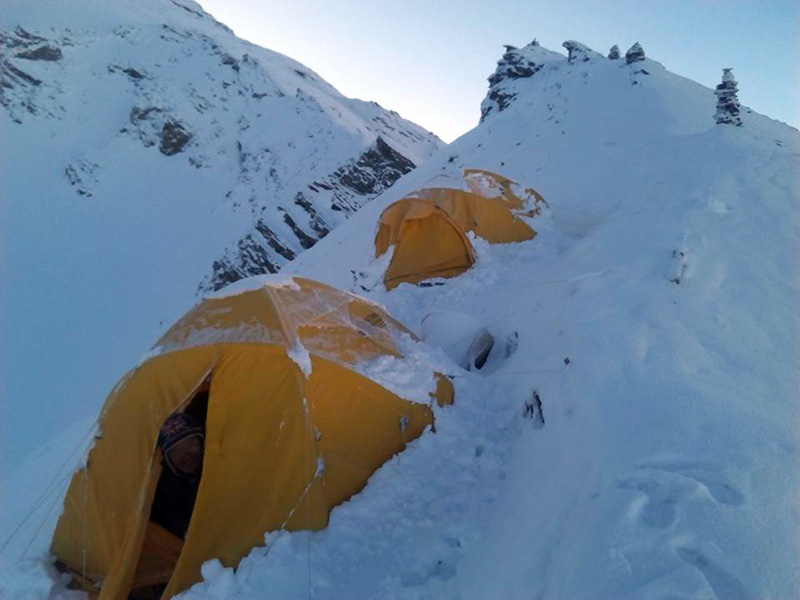 Among the 414 peaks open for mountaineering in the Himalayas, Pisang Peak is one of the most popular 6000 meter trekking peaks and is also one of the most massive rock and ice climbing peaks in the Annapurna region. The western flank of the mountain is guarded by a hanging glacier and offers considerable challenge appropriate for more experienced climbers and has been graded at Peu Difficile.
Among the 414 peaks open for mountaineering in the Himalayas, Pisang Peak is one of the most popular 6000 meter trekking peaks and is also one of the most massive rock and ice climbing peaks in the Annapurna region. The western flank of the mountain is guarded by a hanging glacier and offers considerable challenge appropriate for more experienced climbers and has been graded at Peu Difficile.
Satori can operate this expedition to the Southwest Face. Tea house accommodations are available along the trek to base camp where accommodations at base camp and higher camps are camping. Like most mountains in the region, the best season for climbing Pisang is Spring (April, May) and autumn (September, October, November). However, there is at times very little snow in the autumn season making it difficult to obtain water.
5. Chulu East (6584m / 21,601ft)
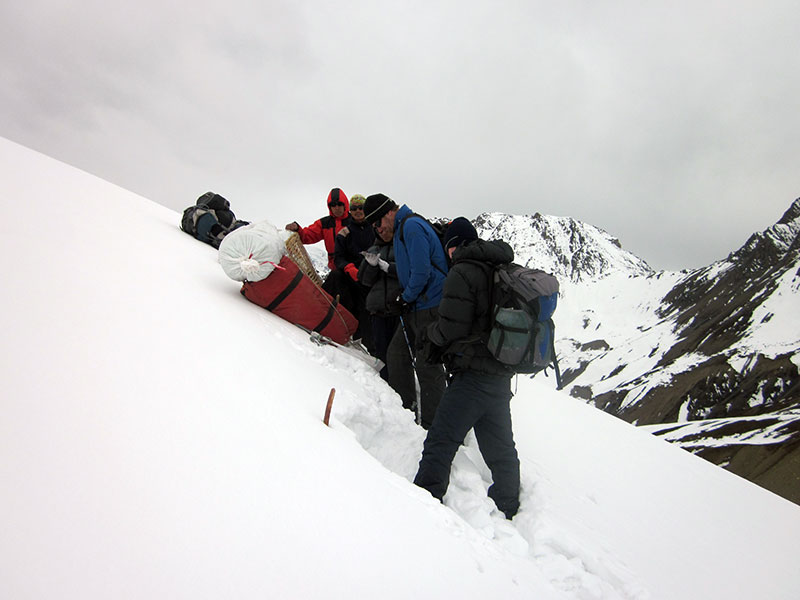 Chulu East is located just north of the Annapurna massif at 28°44’09”N / and 84°02’10” E. With its stunning setting, technical aspects, spectacular 900 meter climbing route and short access to the peak, it makes this climbing objective second to none in Nepal. Chulu East is part of the Chulurange which consists of Chulu West (6429m), Chulu Far East (6029m) and Chulu West (6584m). Chulu East provides breathtaking views of Annapurna (I II, III and IV), Gangapurna, Glacier Dome, Dhaulagiri, Tilicho Peak and Mt. Manaslu.
Chulu East is located just north of the Annapurna massif at 28°44’09”N / and 84°02’10” E. With its stunning setting, technical aspects, spectacular 900 meter climbing route and short access to the peak, it makes this climbing objective second to none in Nepal. Chulu East is part of the Chulurange which consists of Chulu West (6429m), Chulu Far East (6029m) and Chulu West (6584m). Chulu East provides breathtaking views of Annapurna (I II, III and IV), Gangapurna, Glacier Dome, Dhaulagiri, Tilicho Peak and Mt. Manaslu.
Chulu Far East was first ascended in 1955 by a German expedition via the Northeast Ridge, which remains the standard climbing route. Chulu East was first ascended in the spring of 1979 by Dick Isherwood and John Noble also via the Northeast Ridge. It forms an integral part of Manang Himal joining both the Chulu East and Chulu West peaks. We will attempt the summit from high camp (5400m) located just below Chulu Far East (6059m). High camp (also referred to as C1) is located 3.7 km North from Base Camp and the average slope between the two is 22° with an elevation gain of 900m. We take at least one day for acclimation at C1 and more if the client needs it. The summit route is 4.5km from C1 and requires advanced glacier and navigation skills to successfully reach the bottom of the summit ridge. The steepest part of the entire climb is here where climbers encounter a slope of 45° for 450m. Once on the ridge the average slope is below 30° with a distance of 2 km and 600 m of elevation gain. The summit day is extremely long and strenuous, where climbers travel from C1 to the summit and return to Base Camp for a distance of 12 km, an elevation gain of 1400 meter and elevation loss of 1400.
6. Boktoh (6,114m / 20,060ft.)
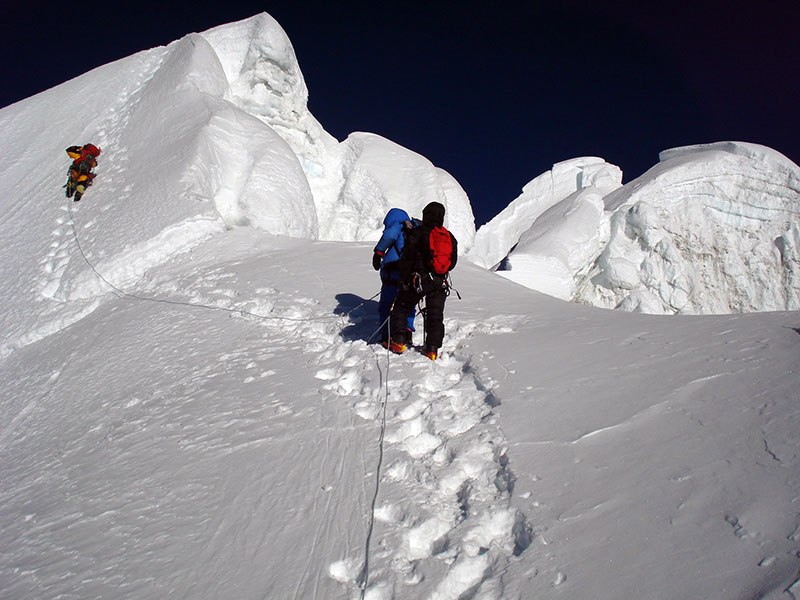 Boktoh is located in one of the more remote areas of the Kanchenjungha South Base Camp. Boktoh became famous in the spring of 1991 when a Slovenian expedition team climbed it as an acclimation peak before attempting Kanchenjunga from its South East Ridge. The trekking trail to Kanchenjunga South Base Camp is one of the most spectacular trails that Nepal has to offer and is a perfect choice for mountaineers seeking a challenging 6000 meter peak provided they have previous 6000 meter climbing experience and experience with high passes. The summit offers beautiful views of Mt Kanchenjunga (8586m/28,169ft), Kumbhakarna (7710m/25,595ft) Dhormo Peak (6850m/22,473ft).
Boktoh is located in one of the more remote areas of the Kanchenjungha South Base Camp. Boktoh became famous in the spring of 1991 when a Slovenian expedition team climbed it as an acclimation peak before attempting Kanchenjunga from its South East Ridge. The trekking trail to Kanchenjunga South Base Camp is one of the most spectacular trails that Nepal has to offer and is a perfect choice for mountaineers seeking a challenging 6000 meter peak provided they have previous 6000 meter climbing experience and experience with high passes. The summit offers beautiful views of Mt Kanchenjunga (8586m/28,169ft), Kumbhakarna (7710m/25,595ft) Dhormo Peak (6850m/22,473ft).
The Boktoh route was opened to trekkers in 1988, although people have trekked the area since the turn of the century. Still, Boktoh is rarely climbed and permits have only been issued by the NMA since 2002 (prior to that time, permits were issued by the Department of Tourism). The semi-technical nature of Boktoh (also known as Bokta to the locals) is deceivingly complex that calls for skills in route finding in addition to other mountaineering peaks. The Boktoh trekking route is shared with the approach to the wild Mt. Kanchenjunga. Continuing on the caravan trail past Bokta Peak brings climbers to Kanchenjunga’s South Base Camp.
The Kanchenjunga region is quite special; its remoteness means there are fewer trekkers.
7. Naya Kanga (5844m / 19,160ft)
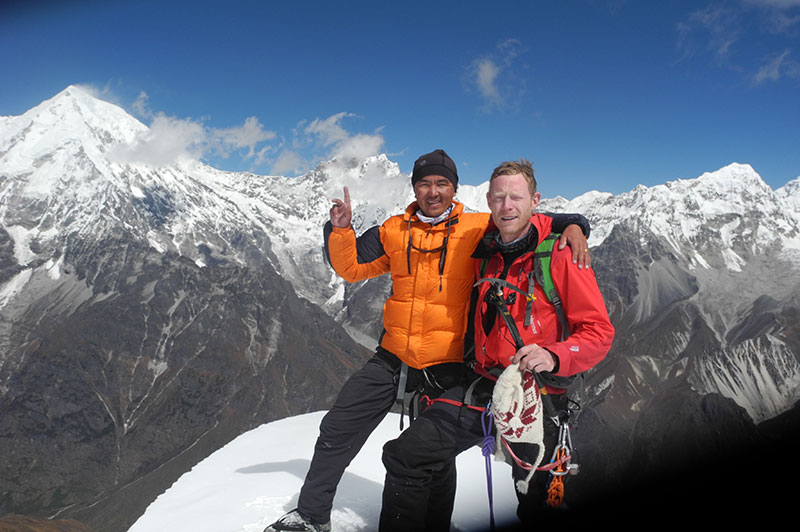 Naya Kanga, which lies in the Langtang region, is accessible to a wide range of climbers; it is beautiful and straightforward – yet also challenging, making it an interesting and appropriate choice for an introductory climb, particularly for those short on time and money.
Naya Kanga, which lies in the Langtang region, is accessible to a wide range of climbers; it is beautiful and straightforward – yet also challenging, making it an interesting and appropriate choice for an introductory climb, particularly for those short on time and money.
Climbers may wish to include Yala Peak into the Naya Kanga itinerary which we recommend as part of the acclimation schedule (Yala is free of permit fees). The normal climbing route on Naya Kanga is via the Northeast Ridge, which follows Kyangjin Gumba (3830m) through the Naya Kanga Base Camp (4300m) and Naya Kanga High Camp (4950m). Beyond high camp is 2.4 km of a snow and ice ridge route with 900 meters of elevation gain and a slope ranging from 25 to 55 degrees. Off the slope and onto the ridge, terrain is at 45 degrees, but those who summit are rewarded with spectacular views of peaks such as Lantang Lirung (7246 m), Lenpo Gang (7083 m), Dorje Lakpa (6990 m) and Shishapangma (8027 m).
8. Saribung (6328m / 20,761ft)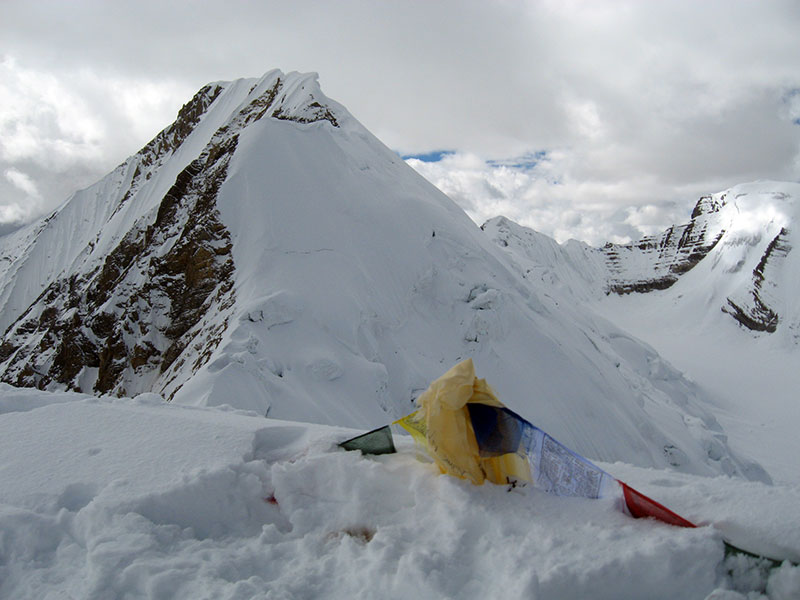 Saribung is a newly popular expedition in mid Western Nepal and lies Northeast from Lo-Manthang near the Nepal / Tibet border. This expedition will provide you with a great opportunity to explore the unique Tibetan plateau of the Himalaya and the villages behind the Lo-Mangtang Mountain. It is challenging with demanding passes, although is an easier choice for those who already have experience summiting other 6000 meter peaks.
Saribung is a newly popular expedition in mid Western Nepal and lies Northeast from Lo-Manthang near the Nepal / Tibet border. This expedition will provide you with a great opportunity to explore the unique Tibetan plateau of the Himalaya and the villages behind the Lo-Mangtang Mountain. It is challenging with demanding passes, although is an easier choice for those who already have experience summiting other 6000 meter peaks.
The Saribung (and Upper Mustang) trekking route was only discovered in 2006. Although the Government of Nepal has opened the area for commercial trekking it is considered restricted on which visitors may only remain a short period of time. Saribung is situated in an isolated part of the Mustang region known as Damodar Himal. The caravan route begins with a 6-hour drive from Kathmandu to Pokhara, and a short flight from Pokhara to the Annapurna village of Jomsom. The trail goes up to Lo-Manthang via Kagbeni, Chele and Charang. After you explore around the Lo-manthang and Luri cave monastery you will visit a region that offers great scenery, culture, monasteries and geographical variations. The approach to Saribung Peak has a few high passes between the Lomangthang and Damodar Kunda.
9. Chulu West (6419 m/ 21,060ft.)
 Chulu West is situated above the Manang Valley with breathtaking views across to Annapurna II, III and IV, Gangapurna, Glacier Dome, Dhaulagiri, Tilicho Peak and Manaslu. If Chulu Far East is the Island Peak of the Annapurnas, then Chulu West is the Mera Peak of the Annapurnas; it is a little more remote and has no real technical difficulty. The caravan route to Chulu West takes you through the classic trek around the Annapurna Massif, ascending the Marshyangdi Valley and crossing the Thorong La, before descending the Kali Gandaki Valley to Pokhara. It begins with a drive from Kathmandu to Beshisahar (790m / 2,591ft), then trekking begins to Kart (1800m / 5905ft), Tinmang (2350m / 7,709ft), Chame (2700m / 8,858ft), Pisang (3200m / 10,498ft), Manang (3400m / 11,154ft), Ledar (4230m / 13,877ft), and Chulu West Peak Base Camp (4000m / 13,123ft). Above Base Camp there is steep, loose rock requiring fixed rope but otherwise the route is primarily a snow climb.
Chulu West is situated above the Manang Valley with breathtaking views across to Annapurna II, III and IV, Gangapurna, Glacier Dome, Dhaulagiri, Tilicho Peak and Manaslu. If Chulu Far East is the Island Peak of the Annapurnas, then Chulu West is the Mera Peak of the Annapurnas; it is a little more remote and has no real technical difficulty. The caravan route to Chulu West takes you through the classic trek around the Annapurna Massif, ascending the Marshyangdi Valley and crossing the Thorong La, before descending the Kali Gandaki Valley to Pokhara. It begins with a drive from Kathmandu to Beshisahar (790m / 2,591ft), then trekking begins to Kart (1800m / 5905ft), Tinmang (2350m / 7,709ft), Chame (2700m / 8,858ft), Pisang (3200m / 10,498ft), Manang (3400m / 11,154ft), Ledar (4230m / 13,877ft), and Chulu West Peak Base Camp (4000m / 13,123ft). Above Base Camp there is steep, loose rock requiring fixed rope but otherwise the route is primarily a snow climb.
10. Kusum Kanguru (6367m / 20,883ft)
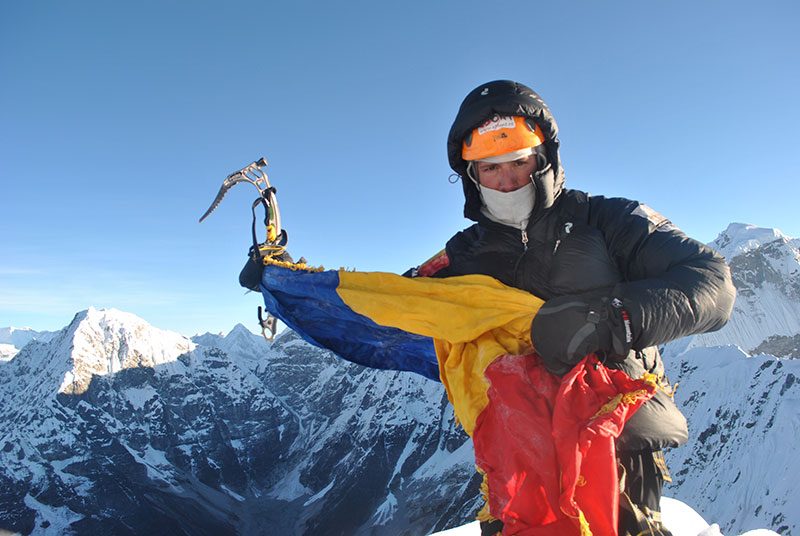 Kusum Kanguru, an impressive rock and ice peak which lies in the Khumbu Valley and forms the border between Dudhkosi in the South and Hinku Valley to the North, is a very technical and challenging peak from all possible routes along the Southeast and North ridges. “Kusum Kanguru” refers to “The Three Snow-White Gods” in the Sherpa language.
Kusum Kanguru, an impressive rock and ice peak which lies in the Khumbu Valley and forms the border between Dudhkosi in the South and Hinku Valley to the North, is a very technical and challenging peak from all possible routes along the Southeast and North ridges. “Kusum Kanguru” refers to “The Three Snow-White Gods” in the Sherpa language.
The caravan route to Kusum Kanguru begins with a scenic flight from Kathmandu to Lukla (2800m / 9186ft), a trek to Chutenga (3350m / 10,990ft), and over the Zatrela Pass to Chatrarbu (4340m / 14,238ft). From here the trek continues to Kothe (3700m / 12,139ft), Yak kharka (4100m / 13,451ft) and onto Kusum Khangaru Base Camp (4780m / 15,682ft). The peak offers a panoramic view of the Himalayas with views of Mt Everest (8848m / 29,028ft), Cho-Oyu (8201m / 26,906ft), Lhotse (8516m / 27,939ft), Makalu (8463m / 27,765ft), Nuptse (7855m / 25,771ft), Thamserku (6623m / 21,729ft), Ama Dablam (6812m / 22,348ft) and Kwongde (6011m / 19,721ft).

